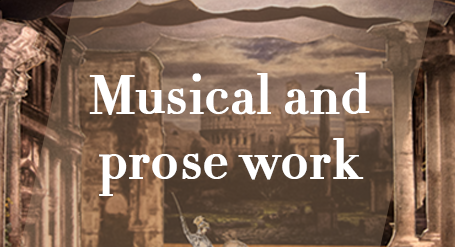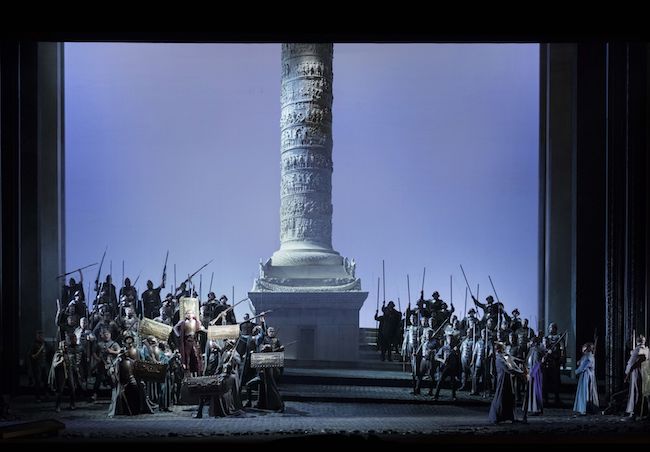
The musical work of Richard Wagner is composed of operas or “musical dramas” ranging from “Fairies” (Die Feen) to “Parsifal”. A detailed presentation of each of these major works is associated here with a set of thematic articles, placing them not only in the context of his personal life but also in his social, economic and cultural context. This section also includes all the musical works (excluding opera) and his literary work.
Rienzi, The Last of the Tribunes, WWV49
Rienzi, der letzte der Tribunen, WWV49
IN SHORT
Grand Opera in five acts
Libretto and music by Richard Wagner,
after Edward Bulwer-Lytton’s novel Rienzi, the Last of the Roman Tribunes (1835)
Premiere :
20th october 1842, Hofoper Dresden, led by Carl Gottlieb Reissiger
![]() Rienzi, der letzte der Tribunen, WWV49 (Rienzi, the Last of the Tribunes) is Wagner’s third completed opera and what is generally considered as the last of his youth operas. The subject is based on the story of Cola di Rienzo, more precisely on the historical novel by Edward Bulwer-Lytton, and takes place in medieval Rome.
Rienzi, der letzte der Tribunen, WWV49 (Rienzi, the Last of the Tribunes) is Wagner’s third completed opera and what is generally considered as the last of his youth operas. The subject is based on the story of Cola di Rienzo, more precisely on the historical novel by Edward Bulwer-Lytton, and takes place in medieval Rome.
Composed between April 1839 and October 1840, Rienzi was first brought to the stage in Dresden on 20 October, 1842, almost at the same time as The Flying Dutchman. While the former was a triumph, the latter, undoubtedly ordered in a hurry by the authorities of the Court of the Saxon Kingdom after the immense success of Rienzi, was not met with the same enthusiasm from the public or the critics.
After dabbling in the German romantic style (The Fairies), then the Italian one (The Ban on Love), Wagner wanted to conquer Paris. He thus created a work along the same lines as the “grand opera à la française” with the will – already – to surpass it: a historical subject developed in five acts with a ballet in the third, large scenes allowing the deployment of vast choral parts, grandiose decorations animated by machineries with spectacular effects and no less than twelve soloists! But the work originally created for Paris, and thus conceived on a libretto in French – nicknamed furthermore by Hans von Bülowas the best opera in… Meyerbeer! – took a quarter of a century to reach the capital.
The true story of Nicola Lorenzo, known as Cola di Rienzo (1313-1354), started in a heroic way. He rose up against corruption in Rome, and this son of a baker pushed the people to rise up against the dominant clans. He got acclaimed as a new tribune, but his megalomania brought him enemies in high places, and he ended up murdered. Wagner takes up the outlines of Bulwer’s novel, but idealizes the hero.
For the production of his colossal work, Richard Wagner seeked the collaboration of renowned singers, including the tenor Josef Tichatschek (in the title role) and his muse, Wilhelmine Schröder-Devrient (in the “travestie” role of Adriano), who was later to play the roles of Senta (The Flying Dutchman) and Venus (Tannhäuser). The performance begun at six in the evening, and ended only after midnight. At the end of the third act, the composer noted, horrified, that “it was as late as if Der Freischützhad been performed in its entirety” (Mein Leben). The day after the premiere, the composer planned to cut the score. He was then met with the fierce opposition of Tichatschek who retorted to the “father” of the work: “I will not let anything be deleted – it’s too divinely beautiful.”
Six performances of Rienzi took place the days after the premiere, receiving each evening an identical success. But, aware of the disproportionate proportions of his work, and especially in order to better get the opera accepted on other stages than the one in Dresden, Wagner offered to cut the work in two distinct evenings (Rienzi’s Greatnessand, the next day, Rienzi’s Fall). This formula never really appealed to the public … who did not understand why they would have to pay twice to see the performance in its entirety! Wagner ended up making severe cuts in the score, and it is in its “hybrid” forms that the opera has since been performed on major international stages.
In different forms then, Rienzi was for a long time a very frequently performed opera, in Germany in particular. In Dresden the 100th performance was given in 1873 and the 200th in 1908. But the favor it found under the Third Reich was fatal. Indeed, the romantic hero charged with a great political mission particularly fascinated Hitler who was offered an autograph score of the opera by the Wagner family for his fiftieth anniversary, which burned in the Berlin fire. Regularly used in propaganda films, the overture to Rienzi became over the years the unofficial hymn of the Nazi party. The opera never recovered from this too great appreciation.
In addition, very long, too long at times, the full version is rarely played and/or recorded. Only the overture is often performed, especially in concert.
It is fair to note that Wagner himself considered that this work was far from representing his views on what music should be: the composer called Rienzi his “howler” or his “youthful artistic sin”.
NC
If you wish to share further information about this article, please feel free to contact us !
